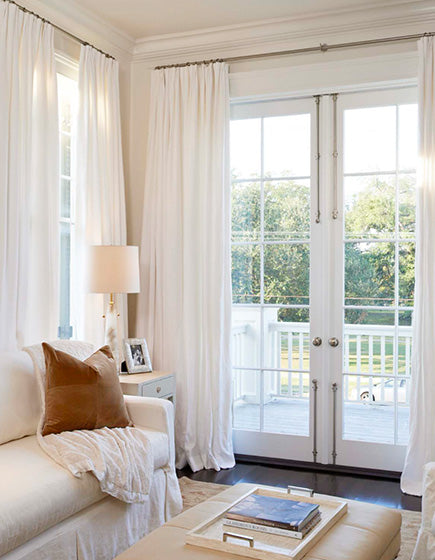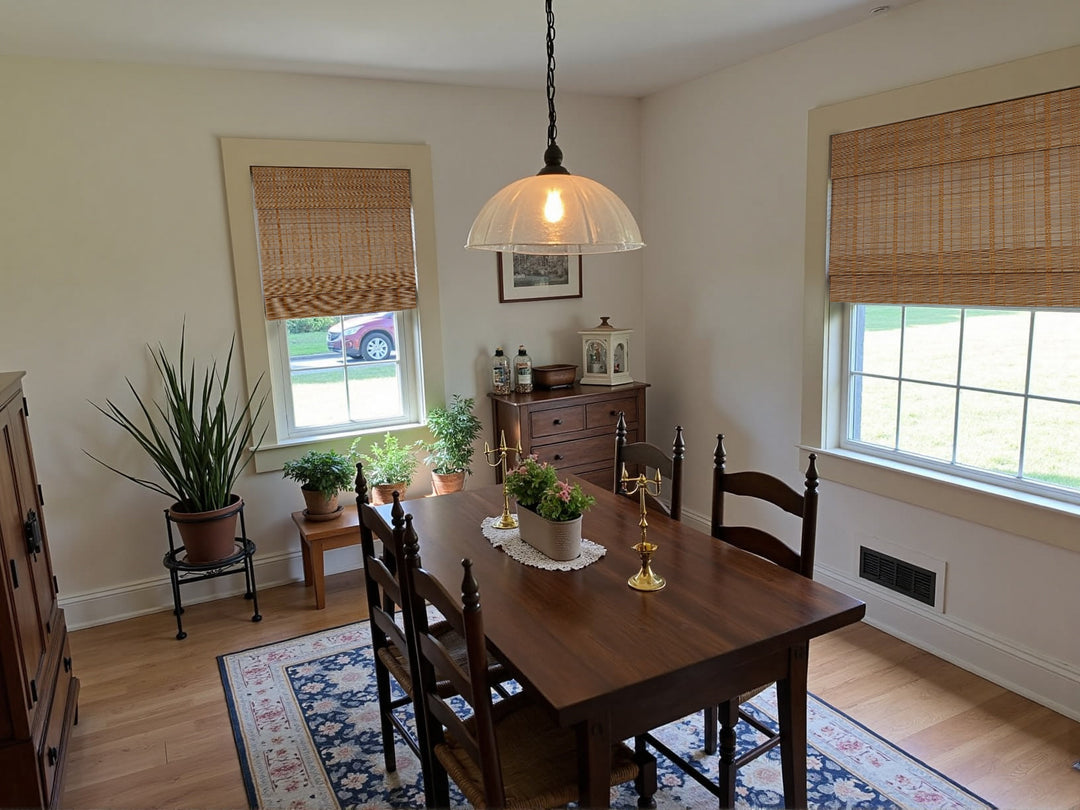A Practical Guide to Curtain Selection and Styling
Curtains are not only functional decorations for blocking light and protecting privacy but also important elements for enhancing the home atmosphere. To create a warm and comfortable home, the choice of curtains is key. Today, we’ll explore some tips for matching curtains to elevate your home style, from color and style to fabric, to create an ideal space that combines both aesthetics and function.

Start with color—choose soft, warm tones like beige, light brown, or soft yellow to create a cozy atmosphere. Next, consider the style. Simple fabric curtains with great drape are perfect for the living room, while Roman shades, with their unique design, are more suited for the bedroom. Lastly, pay attention to the material, as different fabrics bring different textures. These three steps will help you create the perfect home environment.
1. How to choose a solid color curtain?
Option A: Choose a color close to the wall color but a few shades darker.
Note that it’s about matching the wall color, not the floor color. For example, if you have a beige wall (a common choice in modern homes), a slightly darker beige or light yellow curtain would be ideal. Light gray walls are fashionable and bright, so if your walls are like this, light gray curtains would be perfect. If you’re unsure about what to choose from neutral tones, gray is always a safe bet. It’s more practical than white, brighter than brown, and looks more upscale than light yellow. Light coffee is also a common wall color, so you could choose a slightly darker light brown curtain. This “same color family but darker” technique works well for everything from rental homes to large houses, and we highly recommend it.
Option B: The advanced version—choose a color that complements your home’s secondary color.
The secondary color refers to the second most noticeable tone in your home, aside from the dominant colors of the walls and floor. Most people, when looking around, either can’t find a second color or notice a random mix of hues. If that’s the case, go back to Option A. However, if you can identify your home’s secondary color within three seconds, your decor is already above the average standard.
Secondary colors often come from smaller objects with distinct colors or unique patterns, such as coffee tables, rugs, table lamps, cushions, or other decorative items. Large furniture pieces like sofas typically don’t contribute to secondary colors, as they are usually in neutral tones. If you have two or three different secondary colors, the choice of curtain color depends on the specific situation.
Generally, the colors of the coffee table and rug are not ideal references for curtain color, but if the curtains match the color of your sofa cushions, it will blend perfectly. This also follows the “slightly darker than the wall color” guideline from Option A. Matching the curtains with the cushions is a safe choice; they don’t need to be exactly the same, just complementary.
Other textiles can work as well. For example, if your bedding matches the curtain color, it creates a strong sense of cohesion in the bedroom.
Smaller items like table lamps are more suitable as a reference for curtain colors because too much of the same color throughout the home can look overwhelming.
In rare cases, curtains can follow the rug color. However, unless the rug is a neutral tone, it's best to avoid solid-color curtains that exactly match the rug. A hint of the rug’s color in the curtains is enough—avoid making it a perfect match.
For example, if you have a blue rug, you can choose white curtains with blue accents. This will complement the rug without overwhelming the space. However, if you go with solid blue curtains, you can imagine how heavy and intense the entire atmosphere would feel.
There are also cases where curtains follow the color of the sofa, but this works best if your sofa is light-colored. For dark-colored sofas, your space needs to be large and spacious. If the sofa and curtains match, the room needs to be large enough and have other colorful elements to balance it out.
Option C: Choose contrasting and high-brightness curtains.
Vivid colors like fuchsia, bright green, or bright yellow can be an option, but they should be chosen carefully. It’s best to simulate the look first to avoid the curtains becoming the most jarring element in the room, which could make the entire space feel unbalanced.
Additionally, when using high-brightness colored curtains, consider the light effect. If there’s no lining or layering, direct sunlight passing through the colored curtains can cast strange shadows and lighting in the room.
2. How to choose curtain patterns?
If your home is already quite crowded with a lot of artwork, rugs, and cushions in various colors, it's best to go for solid-colored curtains.
If you really want patterned curtains, the top recommendation is the colorful-bordered ones mentioned earlier. A white curtain with a colored border is eye-catching without being overwhelming. These are especially great for children's rooms due to their bright and playful design.
A step up from a border is a two-tone vertical curtain. For example, curtains with a darker color at the bottom and a lighter color at the top, especially if the lighter area is more prominent, visually help to lift the room. This follows the same "darker at the bottom, lighter at the top" principle to create a sense of height.
A bit more than two-tone curtains would be striped patterns. Stripes are a great choice for creating contrasting colors, especially because the white in the stripes provides a smooth transition. Half solid and half striped patterns also offer a fresh and light feeling for the room.
3. How to choose curtain fabrics?
This is actually a bit of a trick question because most curtains available for purchase are a blend of polyester and other fabrics. This isn’t a case of deception by sellers, but rather a practical solution. Single-fabric curtains tend to have various drawbacks. For example, while cotton curtains sound fresh and natural, they are very translucent, prone to wrinkles, and shrink after washing. Pure linen has similar issues—it looks earthy and zen-like but is also light-transmitting, shrinks, and lacks drape when made into curtains.
In addition to cotton and linen fabrics, there are also options like rayon and velvet, most of which are also mixed with polyester. Curtains made from single fabrics usually need to be paired with other curtains to fulfill certain functions, and they’re difficult to maintain. By blending with polyester, these curtains can easily achieve features like light-blocking, good drape, and shrink resistance, making them much easier to care for and more practical.
Instead of focusing on the question of "which fabric should I choose," it’s better to think about "what kind of feel and texture do I want?" For example, do you prefer the fresh, bamboo-linen-like feel, the plush texture of velvet, or the smooth touch of rayon?
Beyond personal preference, the texture of the fabric will also affect the lighting in the room, so the choice should be based on the specific conditions of your home. For instance, in a living room with insufficient natural light, a single-layer, cotton-linen-like curtain would let in light while maintaining a fresh look. In a cold bedroom, velvet curtains with a black lining would be ideal—they provide warmth and block light, making them perfect for sleeping.
4. How to calculate curtain fabric area?
Width Calculation:
For the width, the curtain should extend 4-6 inches beyond the window frame on each side. For thin curtains, you’ll need twice the area of the window frame for pleating, meaning the actual curtain width should be double the width of the window frame. For very thick curtains, doubling the area for pleats might result in overly thick folds or cause them to pile up at the sides when pulled open. In this case, you may want to consider 1.5 times the window width.
Additionally, curtain hooks and rods will affect measurements. For a curtain rod, 1.5 times the window width is usually sufficient. For curtain hooks, you’ll need to account for the fabric gathered at the hook, and typically, this requires 2 times the window width.
Length Calculation:
For the length, we generally recommend that the curtains reach just slightly above the floor. Of course, if you're using fabrics like velvet, you may prefer to let the curtains fall heavily to the floor for a more luxurious look.
5. How to hang curtains properly?
For most cases, a curtain rod works just fine—it’s simple, cost-effective, and practical. However, if the rod length exceeds 8.8 feet, you’ll need to add a support bracket in the middle, meaning the curtains will be divided into two sections. If the budget allows, you can opt for a curtain box with built-in tracks. This allows for a single piece of curtain that covers the entire wall, and adding lighting within the box creates a luxurious, hotel-like atmosphere.
As for the hanging height, we recommend installing the curtains as high as possible. This visually increases the room’s height, making the space feel more open and spacious.
Conclusion
Choosing the right curtains involves considering color, pattern, fabric, and hanging style. Solid colors are versatile, while bold designs like colorful borders and stripes can add personality to your space. Fabric choice should reflect your desired texture and the impact on light and warmth in the room. Proper width, length, and hanging height are key to achieving a polished look.
Explore our diverse range of curtains to find the perfect match for your home. With various styles and fabrics, we can help you create a stylish and functional space. Visit us to discover your ideal curtains today.





